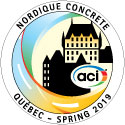Chad Boyea, P.E., a Senior Associate and Senior Project Manager at PES, just returned from beautiful Québec City, Canada, where he attended the Spring 2019 ACI Nordique Concrete Convention held at the Hilton Québec . The chilly spring temperatures of about 8 degrees didn’t stop the attendees from sitting in on a variety of robust sessions at the convention.
Here are the Four Things Chad took away from the Nordique edition of the ACI Spring Conference:
- 3D Construction Printing (3DCP)

- 3D printing is no longer limited to plastic and metal products. There was a lot of buzz at the convention surrounding the relatively new technology of 3D printing with concrete. It is currently being used to build affordable housing quickly. Although the technology is in its infancy, it is not hard to see the potential impact it may have on the construction industry. For more information, check out this article: https://all3dp.com/2/concrete-3d-printing-how-to-do-it-and-application/
- ACI 302.2R – Guide for Concrete Slabs that Receive Moisture-Sensitive Coverings
- Committee 302 is working on updating this document. One of the big changes is some flooring manufacturers are tightening the moisture transmission standards for the concrete, requiring less permeable vapor retarders. Finishes such as VCT tile and epoxy coatings may require the use of 15 Mil thickness vapor retarders to reduce the permeance to acceptable levels. The architect typically specifies the floor finishes; therefore, it is critical that they coordinate the required vapor retarder thickness/permeability with the floor covering manufacturer. Failing to do so could result in premature failure of the floor finish.
- Tilt-up Concrete Trend
- Semi-composite tilt panels (“sandwich panels”) are becoming increasingly popular. This is being driven by stricter energy codes that require continuous insulation to meet the required performance criteria. Sandwich panels have long been used in the precast wall panels but their use in tilt-up construction is relatively new. Its popularity should continue to increase as more contractors and designers become familiar with it, especially given the long lead times that precast panels can have.
- Dominant Joints in Slabs-on-Ground
- Larger pour sizes, extended joint spacing, and the use of vapor retarders is resulting in wider joints in slabs-on-ground. Construction joints usually open the most. It is not uncommon for these joints to open as much as an inch or more. This is commonly referred to as a dominant joint. Dominant joints can become a maintenance nightmare when subjected to heavy vehicular traffic. To mitigate this issue, a nominal amount of rebar is recommended at the construction joints to restrain the movement and force the other sawcut joints to activate.
- It is important to educate owners that dominant joint repairs are not a one-time fix. Concrete is a hard sponge that is heavily influenced by temperature and humidity. There is a direct correlation between climate fluctuations in a building and the frequency of repairs. Non-conditioned warehouses are the worst offenders. Joints will typically stabilize when the building is climatized.
Look for Chad at the Fall 2019 – A River of Knowledge ACI Conference, slated for October 20-24, at the Duke Energy Convention Center & Hyatt Regency Cincinnati in Cincinnati, Ohio.

